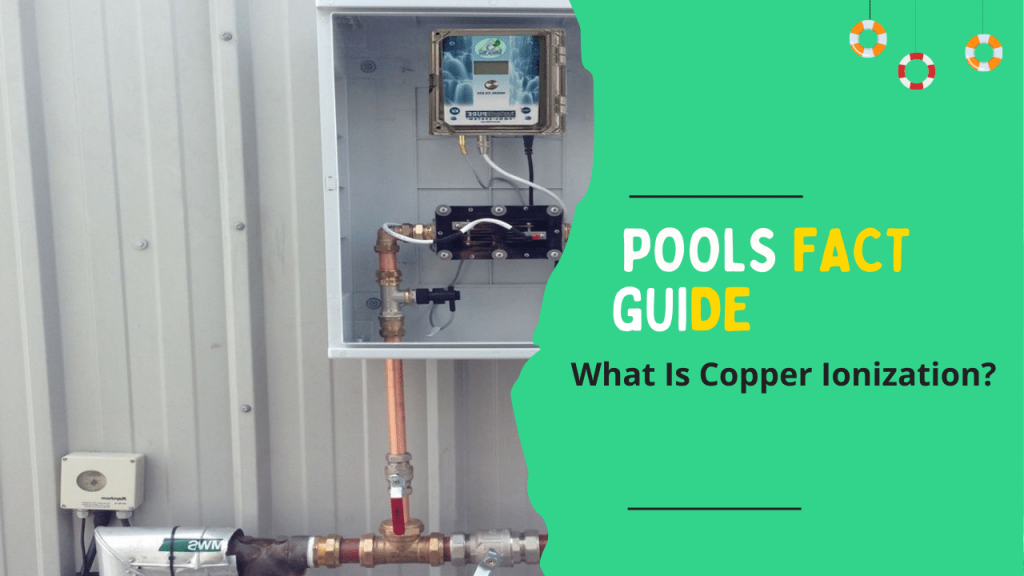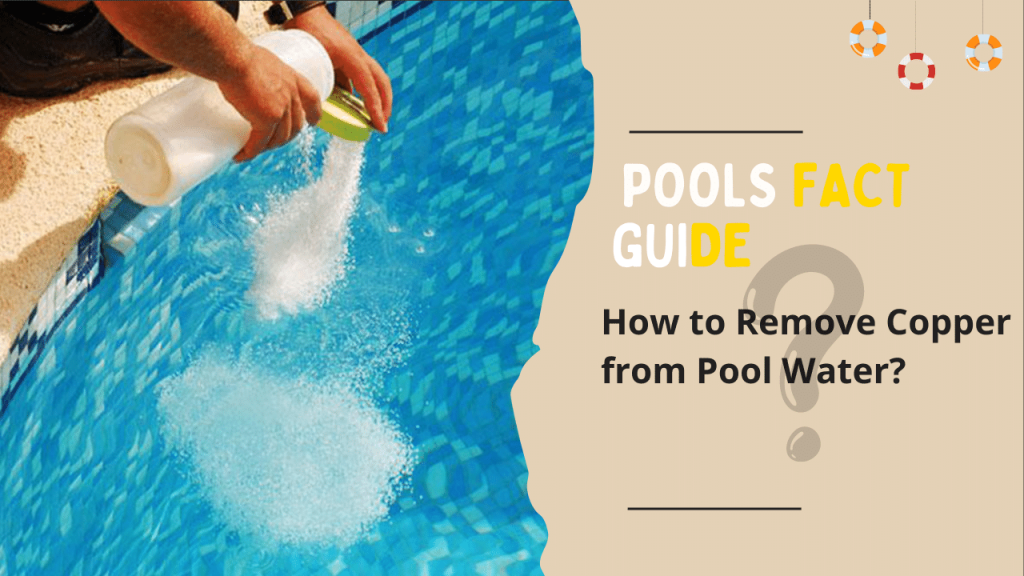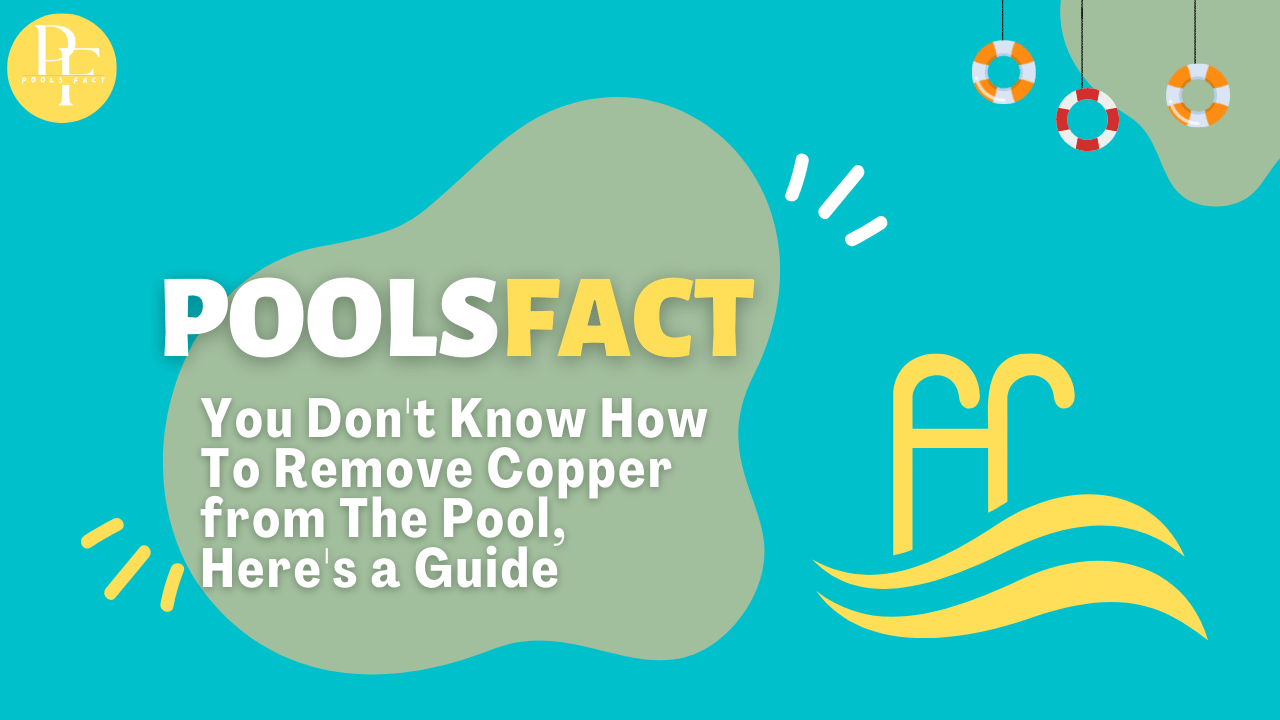If you just bought a pool, you might not have heard anything about copper in pool water or why it’s a problem. After all, copper is a metal. Why would metal be in the water of your swimming pool?
If you’ve ever peered down into a wishing well or other public fountains, you might have noticed a lot of pennies that other people had thrown in. Long-standing pennies are easy to identify since they frequently have a green-grey tint. The colourful substance on the penny is a clue that the water is actively eroding the coins’ surfaces.
There are several sources of dissolved metal in pool water, and metal that has been exposed to your pool water is no different.
In this article, I go over all the typical and uncommon ways copper can get into your swimming pool. In a different piece, I go over how to evaluate the amount of copper in pool water and, if there is any, how to reduce copper in pools.
What Is Copper Ionization?
A low voltage current is used in copper ionisation to discharge copper ions into the pool water. It is a safe method of pool cleaning without the negative effects of chlorine. Copper ionisation is now being used by people all over the world to clean pools and eliminate tenacious microorganisms.

Historical Uses
Since ancient times, copper has been used to filter drinking water. The advantages of utilising copper to cleanse water were discovered by the ancient Greeks. Even NASA utilised copper to filter drinking water for astronauts. Pioneers used copper and silver coins to keep their water safe while travelling west.
How Does Copper Get Into Your Pool?
Water Source
There may be a small quantity of copper already present in your source water (city or well water). If it happens, a little bit more copper is added each time makeup water is supplied as a result of evaporation. Copper accumulates because it does not biodegrade or disappear on its own.
Algaecides
Copper is an active component in some algaecides. Usually, a specific component is added to the copper in algaecide to stop it from colouring people and objects. A chelating agent is what this substance is known as, and copper algaecides that contain it are said to be chelated.
The chelating agent can be destroyed by sunlight, continuous high chlorine or bromine levels, ozone, super chlorination, and even non-chlorine shock treatments. As a result, the copper’s capacity to resist stains is reduced.
Equipment
From the equipment, copper can enter the swimming pool. A small amount of the copper metal in elements like copper pipes, heat exchangers, heater heat sinks, bronze or brass pump parts like impellers or volute assemblies, and even metals used in the filters, really dissolve in water with a low pH.
Corrosion is the term for this. This trace amount of copper dissolves from the machinery or materials and then combines with the pool or spa’s main body of water. Water rushing through copper pipes and fittings is another way that copper enters the water.
Water that is flowing through a pipe at a rate that is higher than what is advised can erode the pipe. This occurs when a pump that is too big for the system that it is in is used.
Placing Chlorine Tabs in The Skimmer
From the apparatus, copper can also enter the water, but for a different purpose. It is standard procedure to add a trichlor tablet (trichloro-s-triazinetrione) to the pool or spa skimmer in order to chlorinate the water. Additionally, some pool owners add bromine tablets to their skimmers.
A piece of the tablet is partially dissolved by water as it passes over it, which then travels through the apparatus and returns to the pool or spa. While bromine pills have a pH of about 4.0, trichlor tablets have an extremely low pH of about 2.8. The pH of the water passing over the tablet becomes low if enough of the tablet dissolves. We have seen pH ranges from 3.0 to 7.0, all of which can lead to the dissolution of metal components.
Note that some producers have created unique trichlor tablets and sticks that are intended to be used with the skimmer. If these goods are used correctly, there shouldn’t be any issues.
Pool pumps in homes run for roughly 6 to 8 hours each day. Spas last 1–2 hours. This indicates that a pump can be off for up to 20 hours per day in a spa and 16 to 18 hours per day in a pool. The trichlor or bromine tablet in the skimmer keeps dissolving even while the machinery is not in use.
As a result, the pH of the pool water in the skimmer as a whole and even further down the pipe below the skimmer becomes extremely low. When the next filter cycle starts, the low pH water in the skimmer goes straight to the equipment, where it dissolves some metal.
Chemicals Added Through the Skimmer
By introducing chemicals through the skimmer while the pump is running, copper can enter the water in yet another method. This is acceptable with some substances. Examine and abide by the manufacturer’s instructions before adding chemicals. However, the same corrosion happens when acid or acidic compounds are applied.
Ionizer
By using an ioniser, also known as a copper/silver or copper ioniser, copper can be intentionally introduced into the water. However, it is crucial that you adhere to any usage instructions provided by the makers when using these products. Maintain the pH within the acceptable range (usually a little lower than NSPI recommended levels).
Use a copper test kit to check the water, then adjust the output to keep the copper level where it should be (usually 0.2 to 0.5 ppm). If instructed, add a sequestering or chelating agent. Pool Ionizers won’t stain if they’re applied correctly.
Also Read: How to Remove Urine from Pool: An Ultimate Guide in 2022
High Copper in Pool Water
For pools, higher copper levels are not permitted. Although there is a limit of 1.00 ppm for copper, it is best to keep it at or below 0.2 ppm. High copper levels can result in green hair, nails, water, and pool walls, as well as pool stains. With the right guidance, lower copper concentrations typically do not result in issues.
It might be advantageous for pool water. For instance, copper sulphate or chelated copper is effective at reducing algae growth in public pools. Additionally, it will improve cleanliness by consuming less chlorine. It is advised against using copper sulphate since it is unsuitable for swimming pools.
It works well as an algaecide in surface waters, including ponds, lakes, and reservoirs. You could use different algaecides in its place.
Why Must Copper in Pools Be Reduced?
If the pH, total alkalinity, or calcium hardness of your pool are also out of balance, you run the danger of oxidising any copper that may be present in the water. There are several issues that this oxidised copper might lead to, which I mention below.
Why Lower the Copper Level in The Pool?
murky water There is a limit to how much-oxidised copper water can contain before reaching saturation. At this stage, typically between 0.2 and 0.4 ppm (parts-per-million), any extra copper can start to free-float in the water and cause a hazy appearance.
Your pool may develop copper stains. The copper eventually makes its way to a solid surface, where it accumulates through a process called plating and can stain pool walls. Soiled with copper in pool water.
More than simply, the pool walls can be stained by copper in pool water. People who have spent a lot of time in copper-rich pools may develop greenish tinges in their hair. Their hair has been very faintly copper-plated!
incorrect test results for water balance. Too much-dissolved metal in pools can cause a condition called “fading endpoint,” which requires a more involved water test that involves first neutralising the metals in the water test sample.
How to Remove Copper from Pool Water?

Step 1: Conduct a Copper Test.
Utilize copper test strips to inspect the pool’s water. For five seconds, dip the test strip in the water. Shake the strip after removing it from the water. To determine whether there is copper in pool water, wait for around 15 seconds and compare the colour on the strip to the kit’s colour chart. The ideal concentration of copper would be zero.
Step 2: Measure pH and Calcium Levels.
Check the pool’s pH. The pH of the water needs to be between 7.2 and 7.3 to balance out the copper in pool. Use a calcium test strip to determine the hardness of the calcium. 350 parts per million of hardness is required to combat copper buildup in the pool. If the pH needs to be changed or the calcium hardness needs to be raised, move on to the next steps.
Step 3: Change the Calcium Hardness
Switch on the pump so it can start filtering. Give the pump at least eight hours to operate. Utilize calcium chloride to increase calcium hardness. Keep the calcium hardness at around 250 ppm in general.
- To increase calcium hardness by 10 ppm, add 2 ounces of calcium chloride per 1,000 gallons of water.
- Use 4 ounces to increase the level by 20 ppm per a thousand gallons of water.
- Use 10 ounces to increase the level by 50 ppm per thousand gallons of water.
Pour the powder into the pool’s deep end.
Step 4: Lower the pH.
Muriatic acid is used to bring down the pH to 7.2 or 7.3. To a bucket, add 1 gallon of water. Fill the bucket with water, then add the right amount of acid. Pour the mixture into the pool’s deep end, keeping it away from the walls and other fixtures.
- 1.25 ounces should suffice. If the pH is between 7.6 and 7.8, muriatic acid per 1,000 gallons of water is added.
- 1.5 ounces is sufficient. If the test result was 7.8 to 8.0, add 1 gallon of acid per 1,000 gallons of water to reduce the pH.
Step 5: Increase the pH
If the pH level is less than 7.2, add soda ash by pouring it into the pool’s deep end.
- 0.75 ounces should suffice. If the pH is between 7.0 and 7.2, add 1 cup of soda ash per 1,000 gallons of water in the pool.
- 1.25 ounces should suffice. If the pH test result is between 6.6 and 7.0, add one cup of soda ash per 1,000 gallons of pool water.
Other Methods to Remove Copper From Pool Water:
On Adding Chemicals to Your Pool
You need to let the algaecide do its work while preventing the copper level in your pool water from rising too much if you do frequently add copper-based algaecides to your pool, which are frequently used to combat persistent algae growth. It’s best to develop a timetable that includes activities like these:
- As Directed by The Package, Add the Algaecide.
- After a week of adding the algaecide but before adding any additional dosages, check your copper level in pool. You should give the algaecide a week to do its job and eliminate the algae in the pool.
- Add a copper sequestering agent or chelating agent if your copper levels are higher than 0.2 ppm.
- After 24 hours, recheck the water’s copper content.
If you do discover too much copper in pool water, you need to add a copper sequestering or chelating chemical to it. This interacts with the molecules of copper to pull them out of the solution, where they may then be filtered and vacuumed out of the water in your pool.
Copper Reduction in Pools Using a Sequestering or Chelating Agent
The clear, dazzling look is impeded by metals dissolved in pool water, which have a tendency to make the water a little cloudy. These substances are frequently marketed as products that make your water shine. Here’s how to use a sequestering agent to lower the copper level in your swimming pool if you suspect there may be copper present in the water:
- To ensure that the water in your pool is balanced and the right amount of chlorine is being used test and balance your levels of calcium hardness, pH, total alkalinity, and chlorine.
The sequestering and chelating agents will function better and more effectively in balanced water if your pool water contains copper. The next step is to rid the pool of copper once your water is balanced. - Check the copper content of your pool. You need to check how much copper you have in your system. 0.2 ppm is OK if a copper ionizer is being used.
- Purchase a sequestering or chelating agent in a bottle or container. They often come in liquid form, though occasionally they do as powders.
- The copper chelating or sequestering agent should be added to the pool. You must follow the directions on the product, some of which say that the substance needs to be diluted before it can be used.
- After 24 hours, recheck the copper level in pool water.
- To ensure that your pool water is balanced and the right amount of chlorine is being utilized, retest and balance your chlorine, pH, alkalinity, and calcium hardness levels. By doing this, you can reduce the likelihood that your equipment will corrode in the future.
- If copper does accidentally end up in the water, balanced water will help maintain it in the solution so that a subsequent copper test can detect it before any staining happens.
Conclusion
Maintaining a copper level in pool that is as low and as close to zero as you can is crucial. Too much copper in pool water can cause stains on surfaces such as walls, fingernails, and hair. You should only 1`ESW Z infrequently see copper issues in your swimming pool with regular testing, balanced pool water, and periodic copper adjusting.

Leave a Reply